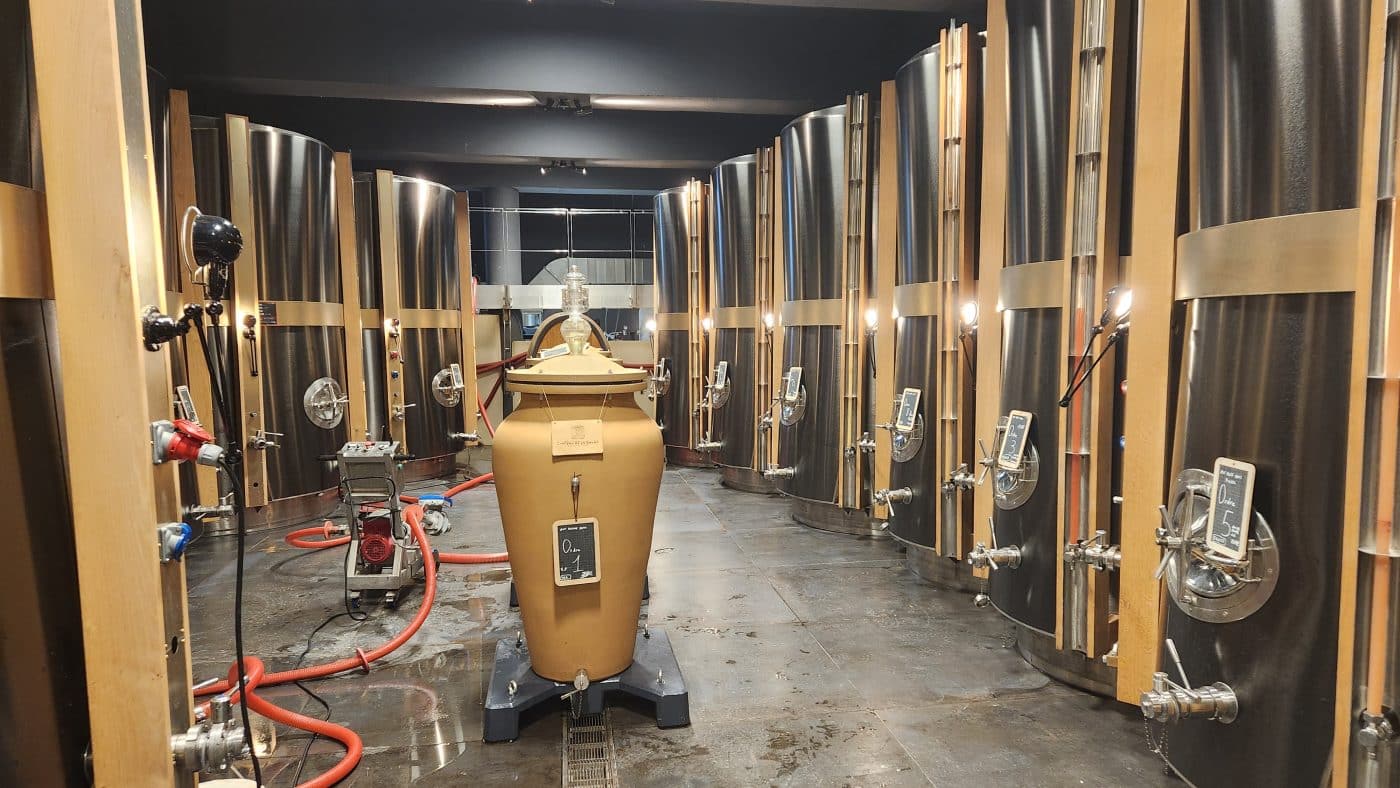Viticulture & Winemaking
Fermentation and Aging Vessels in Winemaking: How Oak, Concrete, Stainless Steel, and Amphorae Impact Wine Flavor
For wine enthusiasts who appreciate the complexities of winemaking, the choice of fermentation and aging vessels plays a pivotal role in shaping the wine’s flavor profile. From the traditional influence of oak barrels to the innovative use of concrete and amphorae, each vessel imparts distinct characteristics that influence a wine’s aroma, texture, and overall experience. In this post, we’ll explore how different fermentation and aging vessels—oak, stainless steel, concrete, and amphorae—impact the wine you drink and why these choices matter for the serious wine lover.
The Traditional Role of Oak in Winemaking
Oak barrels have been a cornerstone of winemaking for centuries, and their influence on wine is both subtle and profound. The primary role of oak in fermentation and aging is its ability to interact with the wine, adding complexity and layers of flavor. Oak imparts distinctive notes of vanilla, spice, toast, and even smoke, which are absorbed by the wine during the aging process. These characteristics evolve over time, creating a wine that is rich and layered.
The choice of oak species also affects the wine’s profile. French oak, known for its subtlety and elegance, tends to add fine, nuanced flavors with a smoother texture. American oak, on the other hand, imparts more robust flavors, with a noticeable sweetness and stronger vanilla notes. The size of the barrel and the level of toasting also influence the degree of oak impact—smaller barrels or heavily toasted oak barrels can provide more pronounced flavors.
Oak also affects the texture and mouthfeel of the wine, softening tannins and lending a smoothness that balances acidity. Red wines, in particular, benefit from oak aging, as it enhances structure and promotes greater aging potential. While oak is the traditional vessel of choice, winemakers are increasingly experimenting with other materials to achieve different styles of wine.
The Emergence of Alternative Aging Vessels
In recent years, winemakers have begun to experiment with alternative fermentation and aging vessels to enhance wine styles and preserve the purity of the fruit. While oak continues to dominate, materials like stainless steel, concrete, and amphorae are gaining attention for their unique contributions to wine.
These alternative vessels allow winemakers to create wines that reflect different textures, flavors, and aging profiles. The use of stainless steel, concrete, and amphorae offers the flexibility to create wines that are true to the fruit and region, without being overshadowed by the heavy influence of oak.
Stainless Steel: Preserving Freshness and Fruit Expression
Stainless steel fermentation tanks are a relatively recent addition to the winemaking toolkit, but they have quickly become a go-to vessel for preserving freshness and expressing the true character of the fruit. One of the key benefits of stainless steel is its neutral properties—unlike oak, stainless steel does not impart additional flavors to the wine. This allows the natural characteristics of the grape to shine through.
Stainless steel tanks are particularly ideal for white wines and crisp, fruit-forward reds. Varietals like Sauvignon Blanc, Chardonnay, and Riesling thrive in stainless steel, as the vessel helps preserve their bright acidity and fresh, clean flavors. Stainless steel fermentation also prevents oxidation, maintaining the purity and freshness of the wine from fermentation through aging. It’s a vessel that allows the grape’s natural aromas—think citrus, green apple, and fresh herbs—to remain front and center.
Concrete: A Modern Twist on Tradition
Concrete fermentation tanks have made a notable comeback in recent years, bridging the gap between the neutrality of stainless steel and the complexity of oak. Concrete, with its porous nature, offers a unique balance by allowing just a small amount of oxygen to interact with the wine during fermentation and aging. This slow oxygenation process can help round out the wine’s texture while maintaining its freshness.
The thermal properties of concrete are another advantage: it naturally regulates temperature, keeping the wine cool and steady, which is especially beneficial during fermentation. The result is a wine that retains the fruit character while developing a fuller, creamier mouthfeel. Many winemakers use concrete for their reds and whites to add structure and depth without overwhelming the wine with oak flavors.
Concrete vessels can also be lined with an epoxy coating to prevent unwanted flavors from leaching into the wine, but some winemakers prefer the raw concrete finish for a more rustic, earthy quality. This trend has led to the creation of wines that showcase terroir with an added sense of weight and texture.
Amphorae: Ancient Vessels for Modern Wines
Amphorae, the clay vessels used in ancient winemaking traditions, have made a resurgence in recent decades. These vessels, traditionally used in regions like Georgia and Italy, are now being embraced by modern winemakers looking for a more organic way to influence wine.
Amphorae’s porous nature allows for slow oxidation, similar to concrete, but with a more pronounced earthy character. Wines fermented and aged in amphorae often have a unique texture, with a mouthfeel that can range from velvety to tannic, depending on the grape variety and the winemaking technique. Additionally, amphorae help preserve the wine’s freshness while adding subtle minerality, which is a hallmark of wines from ancient regions.
The process of fermentation and aging in amphorae also allows for greater interaction between the wine and the natural environment. Many winemakers find that amphorae provide a more direct connection to the terroir, imparting a rustic, earthy quality that reflects the land’s true expression.
The Science Behind Vessel Choice: How Winemakers Decide
The decision of which vessel to use for fermentation and aging is not taken lightly. Winemakers consider many factors, including the grape variety, the desired wine style, and the influence of the local terroir. For instance, cooler climate varietals like Pinot Noir may benefit from oak barrels, which add body and complexity, while fresher whites may fare better in stainless steel to preserve their crispness.
Winemakers also take into account the aging potential of the wine. Oak barrels, with their porous nature, are ideal for wines that will age for years, allowing for slow development of flavors. Stainless steel and concrete, with their inert properties, are often chosen for wines meant to be consumed young, as they preserve freshness and fruit character.
Tasting Wines from Different Vessels: A Comparison of Styles
One of the best ways to understand the influence of fermentation and aging vessels is to taste wines made in different vessels side by side. Wines aged in oak tend to have a fuller body, with rich flavors of vanilla, spice, and toasted nuts. In contrast, wines fermented in stainless steel are lighter, with bright fruit flavors and crisp acidity. Concrete-aged wines offer a balance between fruit freshness and texture, while amphorae wines often have earthy, rustic qualities with complex minerality.
The choice of fermentation and aging vessels is one of the most important decisions a winemaker makes, and it plays a crucial role in determining the flavor and texture of the final wine. Oak barrels, stainless steel, concrete, and amphorae each bring their unique qualities to the table, allowing winemakers to create wines that reflect the character of the grapes, the terroir, and their vision for the wine.
For those looking to deepen their understanding of winemaking, tasting wines from different vessels is an exciting way to explore the subtleties of each material’s impact on flavor. Whether you prefer the rich complexity of oak-aged wines or the fresh, vibrant character of wines aged in stainless steel or concrete, the diversity of vessels offers endless opportunities for exploration and enjoyment.

